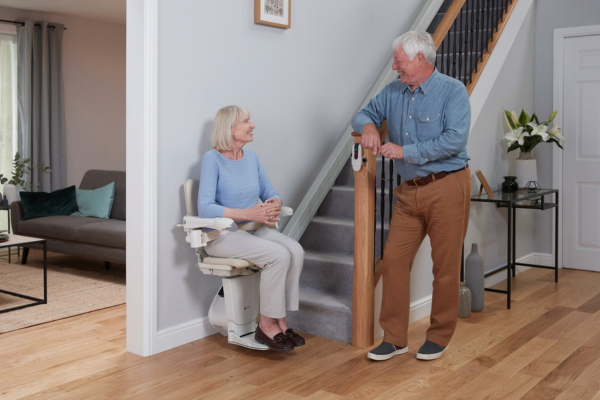A stairlift purchase has the potential to transform your life. It can mean the difference between having the freedom to access your entire house, including your own bedroom and bathroom, versus being confined to the ground floor.
However, there are several potential obstacles that you may encounter. The pricing may not be as straightforward as it appears, and there are specific sales strategies that you should be mindful of. To ensure that you make an informed decision free of any undue pressure, keep the following five points in mind.
Stairlift prices vary a lot
It is undeniable that stairlifts come at a significant cost. In our survey, 14% of participants paid over £5,000 for their new stairlift, while the average price was £3,501.
A straight staircase may require a simpler and more affordable option starting at around £2,000, but the price can increase to £7,000 or more for curved or exceptionally long staircases.
As a general rule, each turn in the staircase can double the initial cost.
Our research also indicates that the price of a stairlift can vary significantly between brands. On average, the least expensive brand in our survey had a new stairlift cost of £3,035, while the most expensive brand charged an average of £3,733.
You’ll pay more than the upfront price
When considering the cost of a stairlift, it’s essential to take into account the expenses beyond the initial purchase price. Before making a decision, inquire about the aftercare services that are included in the quote.
It’s important to note that your contract is with the retailer rather than the manufacturer. If you purchase a Stannah stairlift directly from Stannah, they will provide aftercare services. However, if you buy from a third-party vendor, navigating the aftercare process can be more complicated.
For instance, you may purchase a Handicare stairlift through Companion (a Handicare sister company) or through Age UK, both of which exclusively sell Handicare products. Alternatively, you might buy from a vendor that sells various brands. The warranty and after-care support you receive will differ depending on the retailer, which could be significant as response times and callout charges may vary if the stairlift breaks down.
Larger retailers typically offer a one or two-year warranty as part of the sale of new stairlifts. Of those who purchased a stairlift with a warranty, 64% received at least one free service (23% received more than one), 48% had repairs included, and 39% received replacement parts.
Repairs and adjustments can be costly. The average cost for a repair visit was £224, while servicing cost an average of £211, based on those who paid for repairs and adjustments to their stairlift.
Some companies will pressure you to buy
When purchasing their stairlift, an alarming 44% of customers felt coerced. The degree of pressure experienced varied across different retailers. A staggering 74% of Age UK customers felt some level of pressure, with 16% stating they felt “a lot of pressure,” which is significantly higher than other sellers.
However, it’s important to note that 70% of these customers still believed they received a good deal. Only 15% of those who bought from an independent or authorized dealer reported that they felt any pressure.
The British Healthcare Trades Association provides clear guidance on what it calls “inappropriate selling techniques,” which include tactics like “a high initial price followed by the offer of a discount (often followed by a telephone call to the ‘manager’)” and “a discount on the condition that the consumer agrees to the sale that day.”
To prepare for a home visit, there are certain steps you can take to ensure that you ask the right questions and can detect any underhanded tactics. For instance, it can be beneficial to have a friend or family member present during the visit, and for more complex situations, you may want to have an occupational therapist present
Haggling can be fruitful or off-putting
If you’re not a fan of negotiating prices, it’s best to choose a company that offers transparent pricing. Prices should be clearly stated in promotional material and given to you early in the sales process, according to industry guidelines.
For those who enjoy haggling, our survey found that 32% of new stairlift buyers were able to negotiate a price reduction, with 25% receiving additional features or services.
However, success rates varied between brands. For example, 44% of those who tried to negotiate with Acorn were successful, while 60% of those who tried with Stannah were unsuccessful in lowering the price. Stannah stated that their prices are final and not negotiable.
Don’t count on making money if you sell your stairlift
According to our survey, nearly three in 10 (29%) people investigated buy-back options for their stairlift once it was no longer needed.
Of those, 46% were satisfied with the buy-back cost, while 38% were dissatisfied.
Manufacturers caution that the value of the stairlift drops significantly after it’s sold, much like with cars. For example, Stannah noted that the buy-back could be as little as 5 to 10% of the original value.
When purchasing a stairlift, it’s important to ask about the resale value, which will depend on various factors like the age and condition of the stairlift, as well as any stipulations in the contract, such as regular servicing.
One person reported feeling misled: “They talked up the buy-back service but didn’t mention that it would only be worth the scrap value of the metal.”
However, another person stated that their company was transparent about the buy-back price: “They explained everything, including the buy-back price which is basically for the chair alone.”
Lastly, a third person was disappointed when they were unable to take advantage of the minimum buy-back figure they were told about: “When my mom passed away, there was no buy-back offer available. They even wanted me to pay them to remove the stairlift. I was not impressed.”


